What is Kajabi?
Kajabi is an all-in-one online tool that allows you to set up everything related to courses and memberships. On the platform, you can build your website, assemble and make your courses look very professional, host your courses and other large files, automate your entire email marketing (saving you costs for tools like MailChimp!), and even organize live events.
It’s a very comprehensive platform that also looks very good. It’s user-friendly, and anyone can get the hang of it. It’s a bit on the pricey side, but I’ll talk about that later.
Functionalities
Kajabi has many proprietary functions, which I will elaborate on below. I might forget a small function here and there; it’s really extensive.
Building a Website
First off, within Kajabi, you can build your own website. And they don’t look bad at all. You can choose from a plethora of themes with all kinds of presets, allowing you to have a nice website up and running within fifteen minutes.
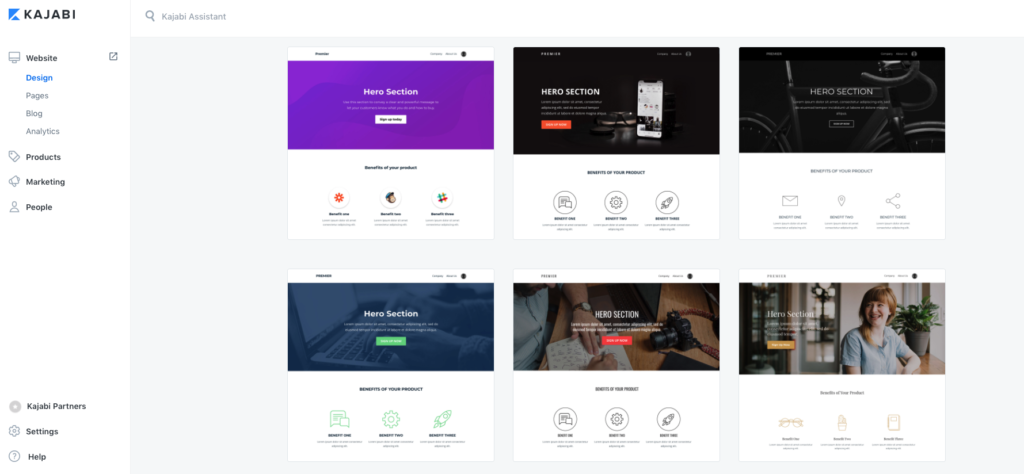
Themes and Features
After choosing a theme, you can fully customize your pages as you wish. This can be done with Kajabi’s special Drag and Drop Builder. You have a choice of different elements, a selection:
- Blog Posts
- Countdown Timers
- Call to Action
- Custom Content
- Facebook Comments
- Features
- Headings
- Hero
- Image
- Image Gallery
- Link List
- Logo List
- Offers
- Opt In Form
- Opt In Form Bar
- Pricing Options
- Showcase
- Slideshows
- Spacer
- Testimonials
- Text
- Text & Image
- Video
- Video Embed
And new features are constantly being added.
After clicking on the features, you get a preview of what it will look like. You can test Kajabi here for 28 days.

Your Own Blank Page is Also Possible
In addition to choosing a standard theme, you can also choose to start with a blank page. You can then arrange many elements as you wish. Of course, you’re somewhat bound to a Kajabi framework, but there’s a lot possible. Hopefully, more ways to further customize your website will be available in the future. For designers among us, some aspects could still be improved.
Mobile Friendly
Your website is also made mobile-friendly right away. So, you don’t have to worry about that at all. You can preview this in your back-end at any time.
Blog
It’s also possible to create your own blog via Kajabi. Okay, it’s not a WordPress blog but still quite neat. You have your own text editor where you can also make adjustments fairly easily. Just like WordPress, you can add categories, photos, make HTML adjustments, change URLs, and more.
And what about the SEO/visibility of Kajabi websites?
You can get quite far with the adjustments you can make on the SEO front. Within texts, you can apply the usual headings (H1, H2, H3), etc., and you can also adjust titles and descriptions. In addition, you can place JavaScript codes in the
elements on your website, useful for canonicals, Tag Manager, etc. The downside is that JavaScript and the plugins on the website do slow it down somewhat. So, you do need to pay close attention to the size of photos on your website. They are not automatically compressed or anything. There’s still room for improvement there. However, with Kajabi, you can still achieve load times under the 2 seconds recommended by Google. I must admit that I have not really optimized for visibility in the scan I put below from Uptrends, as it was not yet finished at the time of writing.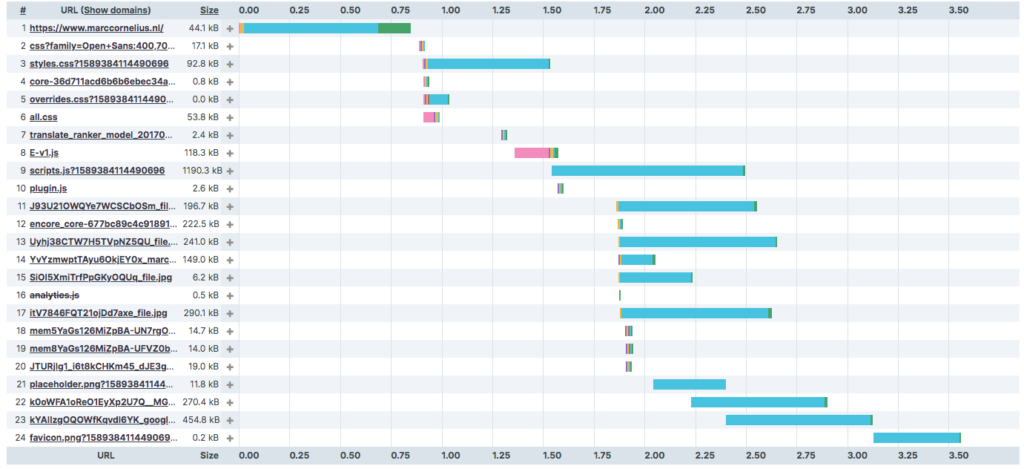
Setting Up Courses
Then actually the showpiece of Kajabi: the courses. Most people choose Kajabi for the possibilities it offers regarding courses. And I understand why.
First, you can create separate courses each with their own topic. You can organize the courses hierarchically as you wish with the handy drag and drop system in the back-end.
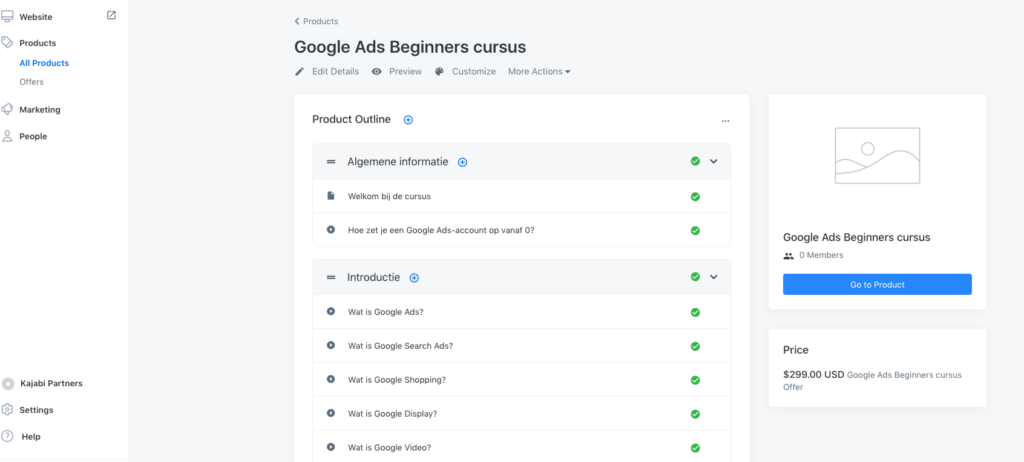
In my case, I made a Google Ads course. I knew I couldn’t cram everything into one video, so I divided everything into multiple segments. It looks like the image above. Within each of these courses, you can add downloads, create assignments, add accompanying text, and people also have the option to comment, if you want. In addition, you can also send automated emails when someone has completed a course, stopped halfway, or forgotten.
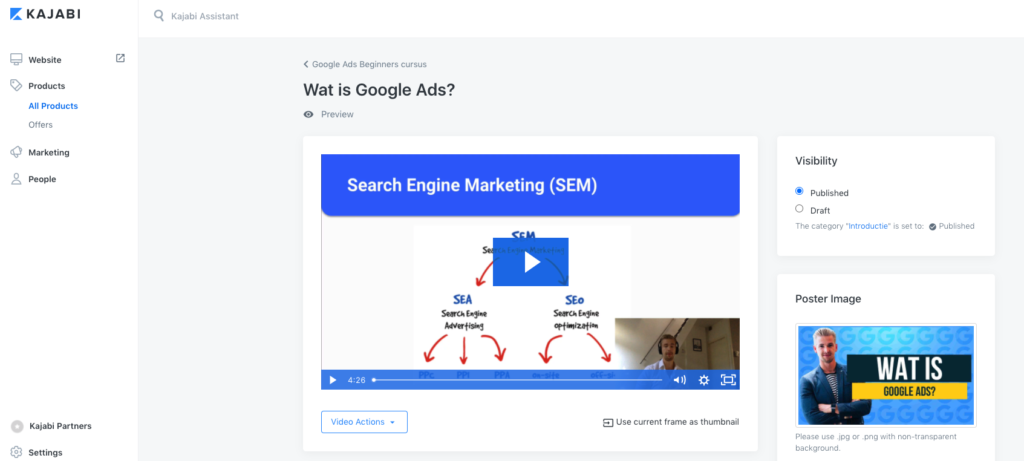
In terms of look and feel, Kajabi is really top-notch with courses. Better than any other platforms I’ve tried. You can also arrange the course environment as you wish. It works the same as the website editor. With drag and drop.
You can make the courses as large as you want. You set your own prices, and can also add nice thumbnails to your courses. It’s also possible to post Announcements, so all students receive an email when a new course is added, for example.
When you want to upload your courses, they can simply be uploaded to Kajabi’s platform itself. Videos up to 4GB can be uploaded without limit. So, you don’t have to deal with YouTube embedded videos, although the latter is still possible.
Another element you can add is a so-called Evergreen Training. With this training, you can automatically send new content weekly. This can be used if you offer a 4-week program, for example.
Email Marketing Automation
When I purchased Kajabi, I actually didn’t know this. I often read too quickly. But another cool feature of Kajabi is that you can set up entire email marketing campaigns and automate them where necessary.
You can create entire email flows. For example, I designed an automated Google Ads Email Course with fairly basic tips. But that doesn’t matter; you have email addresses of people who could potentially purchase your course.
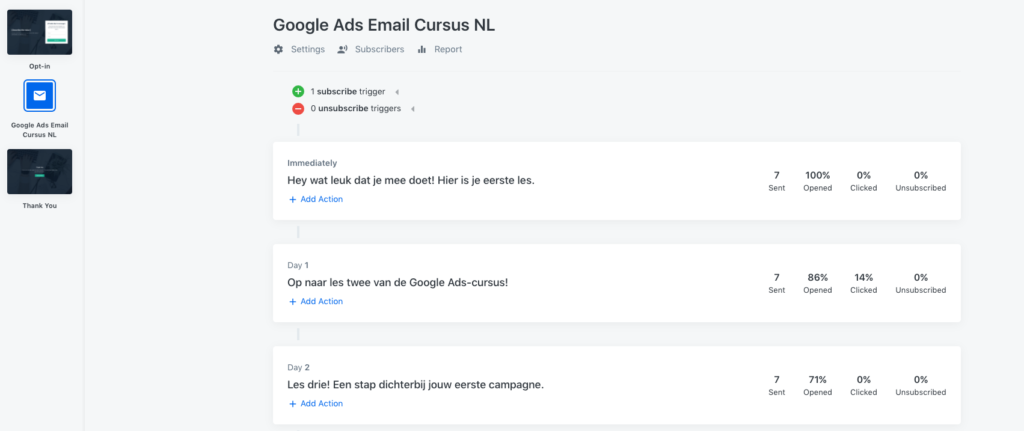
You can personalize the emails as much as you want. You get a text editor that allows you to make HTML adjustments, add images, signatures, etc. Essentially the same editor as the website editor.
Events
Within Kajabi, it’s also possible to sell your (live) event. Think of a live training, a live course, etc. After payment, people can enter an Event environment where they can see your video. That video can simply be embedded from Youtube. Whatever you want.
You can also create good landing pages to explain your Live Event well and persuasively. These landing pages are quite conversion-oriented, so that’s also great.
Your Own Affiliate System
This is really great and quite recent that I found out. Kajabi has its own affiliate system. An affiliate system is a system that lets people market your product for you, and in return, they receive a commission on a sale you make thanks to them. A sale that might not have happened otherwise. This is one of the most cost-effective forms of marketing, which is why I’m so excited about it. Normally, you’d have to join Tradetracker or Daisycon, but thanks to Kajabi, that’s a thing of the past.
You can set your own commissions, and you also have the option to approve your affiliates yourself + you can see where you’re being promoted. So, you always have control over where and what is said about you.
Your Own Community
Setting up your own community is also possible. If, for example, you want to sell memberships for masterminds or something similar, this is a nice option. Users can chat with you publicly here. Valuable answers you give become visible to everyone. Another advantage of a community is that you create a loyal member base. People keep coming back. And then you can sell other courses to them, for example :).
Payments
There are a few things you need to know about payments with Kajabi. When someone wants to purchase a course from you, they cannot yet pay via iDEAL. You can only pay as a customer via Credit Card (Stripe) or PayPal. A miss, because iDEAL does provide extra value as a payment method, I think. It is possible via a platform like LinktoPay. With it, you can still link iDEAL to Kajabi. But that costs you a few extra tens of euros per month. This is a disadvantage of Kajabi, although they are working on it. So, who knows, we might have this option in the near future! Fortunately, PayPal is also widely used in the Dutch market.
Support
I’ve asked support a few questions several times, and generally, they respond within 4 hours. The queue is always quite long, so you don’t get a response within a few minutes.
Prices
Kajabi operates on a subscription model. Prices below are monthly based on annual payment. You can also pay monthly.




